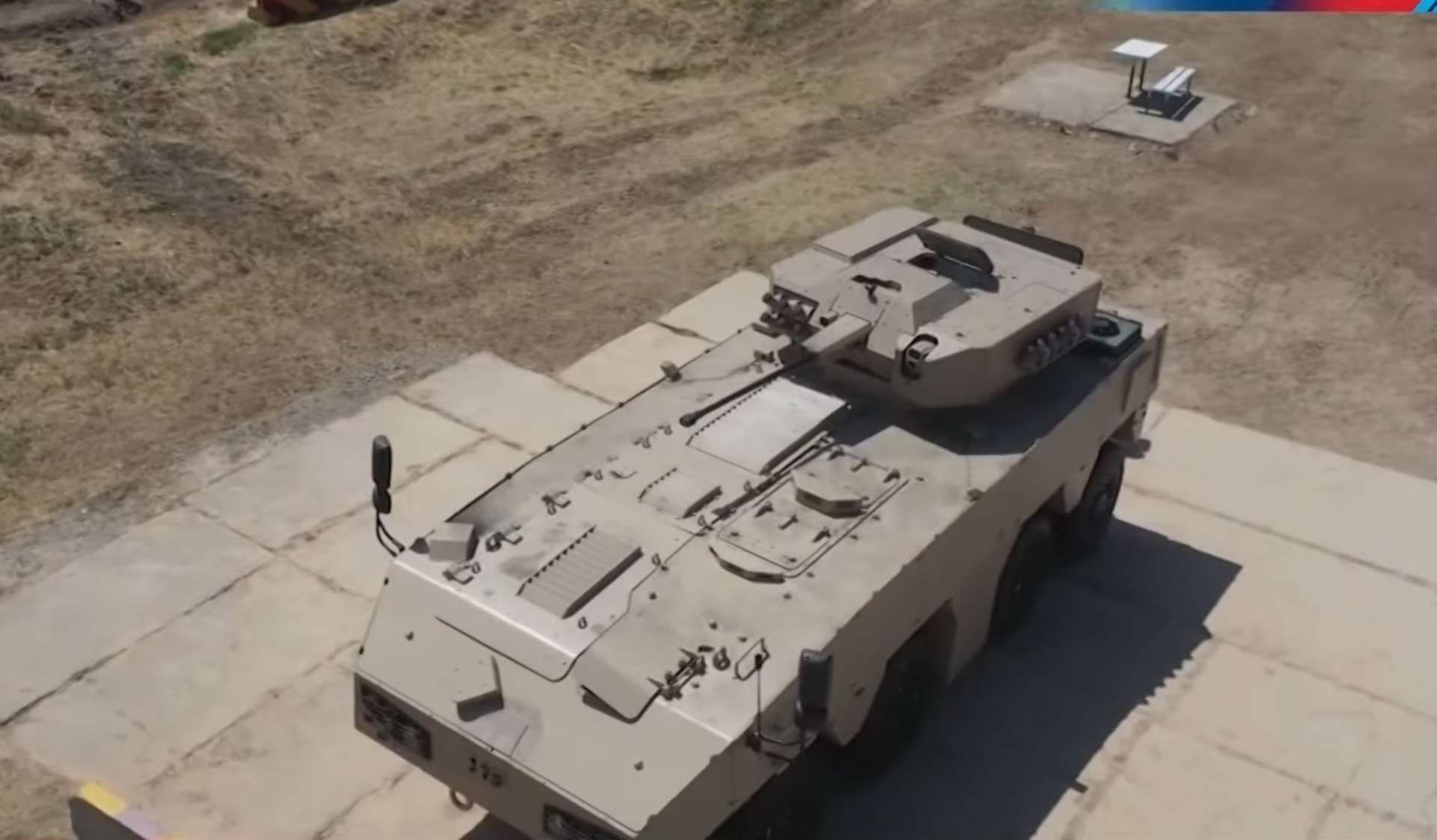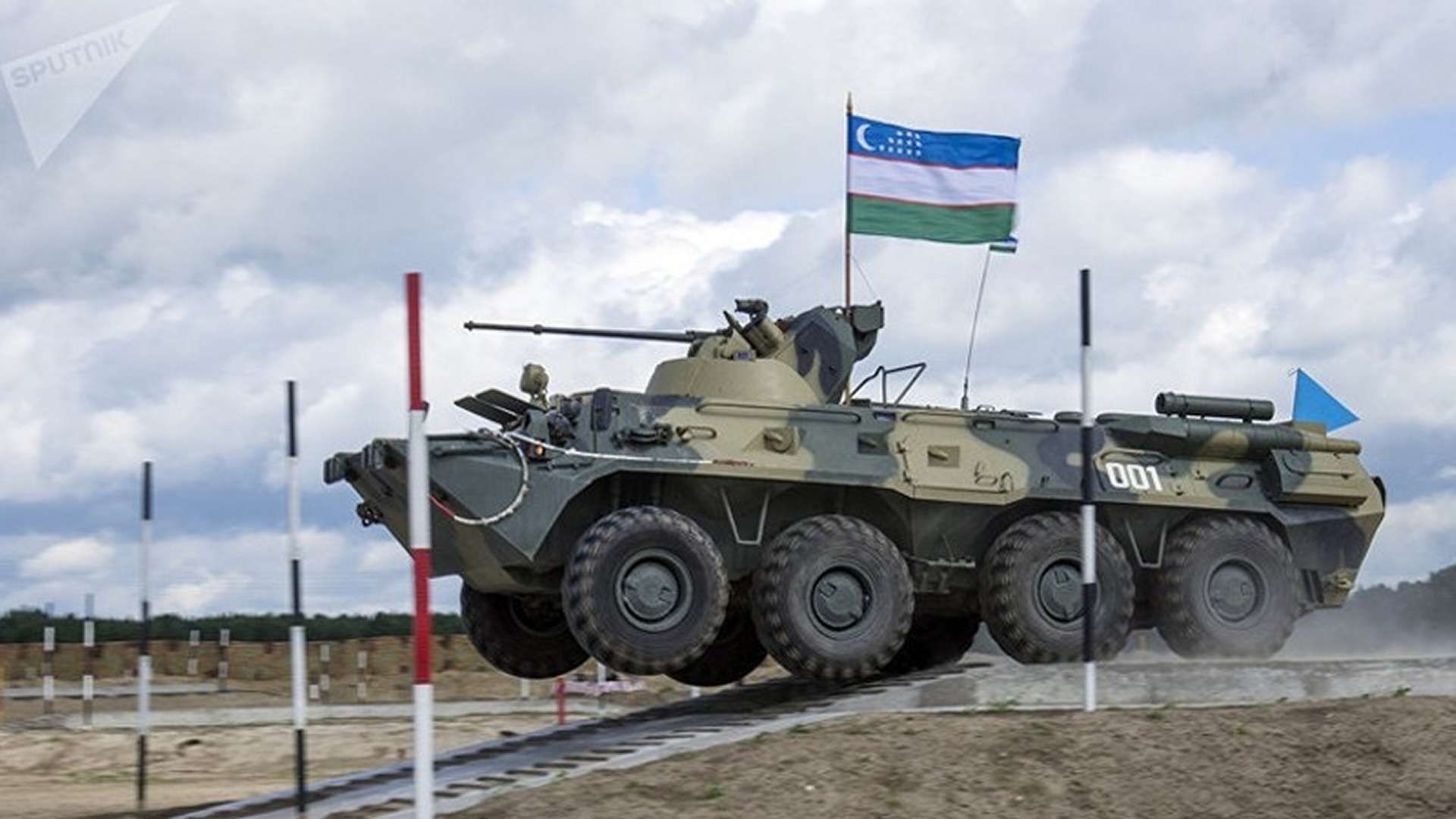On July 15, 2024, Uzbekistan’s national broadcaster MTRK reported that the first domestically produced Arslon 8×8 armored personnel carrier (APC) and the modernized Tarlon-M 4×4 armored vehicle are undergoing field testing, with subsequent delivery planned for the Uzbek army. Additionally, the reports announced that the Uzbek army will receive a batch of this updated generation of the Tarlon armored vehicle.

The Arslon’s front protection is claimed to meet STANAG 4569 Level 6 (30mm APFSDS at a distance of 500m), with side and rear protection meeting Level 4 (14.5mm AP at 200m), and blast protection at Level 4a and 4b, equivalent to 10 kilograms of TNT under the wheel or belly. (Picture source: Uzbek MoD)
According to the MTRK report, the ‘Arslon’ (Uzbek for lion) is the outcome of extensive studies and analysis of foreign APCs and was produced through the cooperation of different organizations within the Uzbek Defense Industry Agency. The vehicle was assembled by Krantas, a Tashkent-based equipment and agricultural machinery manufacturer, that has previously participated in the development and production of the Tarlon and Qalqon 4×4 APCs. Assembly took place at the same plant where the Qalqon was built.
Depending on the configuration, the APC weighs between 32 and 35 tons, and follows a conventional layout, with the engine located in the front right and the crew next to it. The crew, composed of a driver, commander, and gunner, is seated one behind the other. The gunner accesses his station via the troop compartment at the rear of the APC, which contains seats for eight paratroopers and is accessible through a rear hydraulic ramp. For comfort, the vehicle includes an air conditioning unit.
According to Jan Kerdijk, the Arslon 8×8 is equipped with a Guardian 30 weapon station by the Spanish company Escribano Mechanical & Engineering. The weapon station is placed directly upon the Arslon’s troop compartment. It is normally fitted with a MK 44 Bushmaster II, though Escribano M&E promotes the possibility of installing the Soviet 2A42 30mm autocannon. The Uzbek Army chose this option, given the presence of BMP-2s (with the same gun) and BTR-82As (with the related 2A72 using the same ammunition) in its arsenal. As a secondary armament, a 7.62mm machine gun is mounted coaxially to the main gun.
While other configurations of the Guardian 30 feature a panoramic sight, the weapon station acquired for the Arslon does not. The commander’s station may include a screen mirroring the gunner’s sight but is otherwise limited to the three periscopes in front of his hatch. Cameras at the front and back, supplemented by four additional sensors at the front, back, and sides of the APC, enhance the situational awareness of the driver, whose station is also highly digitized.

The Uzbek Army chose to use the Soviet 2A42 30mm autocannon, given the presence of BMP-2s (with the same gun) and BTR-82As (with the related 2A72 using the same ammunition) in its arsenal. (Picture source: Uzbek MoD)
The Arslon’s front protection is claimed to meet STANAG 4569 Level 6 (30mm APFSDS at a distance of 500m), with side and rear protection meeting Level 4 (14.5mm AP at 200m), and blast protection at Level 4a and 4b, equivalent to 10 kilograms of TNT under the wheel or belly. The use of the NATO rating is noteworthy, as when the Tarlon 4×4 was first revealed in 2020, the Uzbek MoD stated its protection according to both the Russian GOST 34282-2017 and NATO STANAG 4569. Later promotional material for the Tarlon or Qalqon IMVs exclusively featured the Russian standard. For the Arslon, no GOST values are provided, aligning with MTRK’s emphasis on the Arslon’s compliance with NATO standards.
Another Western supplier is identified by the presence of a socket from Erich Jaeger GmbH + Co. KG, a German automotive electronics manufacturer, installed in the APC’s front. This specific 12-pin 24V connector is designed for military users and has a NATO stock number. Additionally, the vehicle features a “Leitkreuz,” a rear convoy guidance cross originating in the German Bundeswehr and adopted by several NATO armies. This accessory has not been used by the Uzbek Military before.
Uzbekistan’s defense industry has utilized Western components before; for example, the Tarlon was fitted with a Cummins engine and an Allison transmission. Compliance with NATO standards was previously less emphasized compared to the Arslon. No information has been provided regarding the vehicle’s engine and transmission, but it is likely that they were sourced from a Western supplier.

The 13.5 to 14.5-ton Tarlon-M 4×4 armored vehicle, now in its fourth version, features a hull made of composite materials with polymer armor. (Picture source: Uzbek MoD)
Adapted to various climatic conditions in Uzbekistan, the Arslon is intended for import substitution and might serve as an alternative to further purchases of the Russian BTR-82A, alongside which the Uzbek Tarlon-M APC was filmed at a firing range. Uzbekistan’s armed forces have faced a lack of wheeled APCs, a problem inherited from the Soviet Army. The MoD has primarily purchased Russian BTR-82As and older BTR-80s. The Arslon could be a more modern and capable vehicle to address this gap.
Interestingly, the video about the Arslon was also shared by Uzbekistan’s National Guard, which is unusual as the security force has not previously published material concerning domestic military equipment projects. While the Milliy Gvardiyasi operates some heavier equipment up to BTR-80s, nothing in its arsenal matches the Arslon in terms of weight and capability. The Arslon would represent a significant increase in capabilities for the institution.
On the other hand, the 13.5 to 14.5-ton Tarlon-M armored vehicle, now in its fourth version, features a hull made of composite materials with polymer armor. It is mounted on an all-wheel-drive 4×4 chassis, providing high cross-country capability. The vehicle measures 6,300 mm in length, 2,500 mm in width, and 2,650 mm in height. The Tarlon-M is equipped with a closed digital and satellite communication system and a combat module with a 14.5 mm cannon, developed by domestic engineers. The vehicle has an engine power of 155 hp, allowing it to reach a maximum speed of 105 km/h and a driving range of 750 km. This vehicle is designed for patrolling, performing special tasks in dangerous areas, protecting troops, and transporting landing forces and columns. It is used for fire support of mobile groups and checkpoints, combat patrols, and the security of troops and transport columns.

As of 2023, the Uzbek army’s inventory of Infantry Fighting Vehicles (IFVs) comprised 270 BMP-2 vehicles and an estimated 100 BTR-82A vehicles. (Picture source: Sputnik)
As of 2023, the Uzbek army’s inventory of armored fighting vehicles (AFVs) includes a Main Battle Tank (MBT) fleet consisting of 340 tanks, such as 70 T-72 tanks, 100 T-64B/MV tanks, and 170 T-62 tanks. The reconnaissance (RECCE) vehicles include 19 units, with 13 BRDM-2 and 6 BRM-1 vehicles. Infantry Fighting Vehicles (IFVs) are represented by a total of 370 units. The inventory comprises 270 BMP-2 vehicles and an estimated 100 BTR-82A vehicles.
The Armored Personnel Carriers (APCs) in service number 388, with a breakdown of tracked and wheeled variants. The tracked APCs include 50 BTR-Ds, while the wheeled APCs total 338 units, including 24 BTR-60, 25 BTR-70, and 210 BTR-80 vehicles. The Protected Patrol Vehicles (PPVs) inventory includes 79 units, featuring a mix of Cougar 4×4, 24 Ejder Yalcin, 50 MaxxPro, and 5 Typhoon-K 4×4 vehicles. Armored Battlefield Command Vehicles (ABCVs) include 129 units, with 120 BMD-1 and 9 BMD-2 vehicles. These ABCVs serve as mobile command posts, equipped with communication and control systems to coordinate battlefield operations. Additionally, the Uzbek army possesses a variety of Armored Utility Vehicles (AUVs), with a total of more than 11 units. This includes 7 Cougar vehicles, 4 M-ATVs, and an unspecified number of Tigr-M vehicles. These AUVs perform various support roles, from logistics to troop transport, enhancing operational flexibility.





